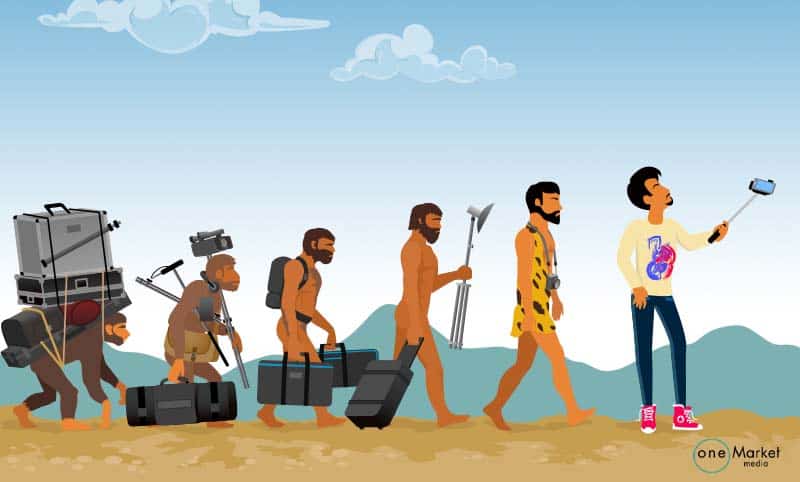The window of opportunity for pure-play video production companies is beginning to close.
I’m revisiting a blog post I wrote 5 years ago about the state of video production companies to see where the video production industry is today and how it continues to evolve.
Ten or fifteen years ago, video production was conducted on a relatively even playing field. You either owned or leased $100,000 worth of camera and editing gear or you didn’t.
Everyone used similar techniques and technology and, as such, the quality of the content was the big differentiator in the industry. While the barriers to entry were high, the key success factor was the quality of your work (as it should be…)
Then around 2007, things got a little messy.
Equipment 2.0 – Technology advances quickly.
Adobe got serious about video software and Canon and Sony began to court the lower end of the professional equipment market.
All of a sudden, everyone could afford decent or good quality production equipment. The rate of change in technology has continued apace ever since.
Who would have guessed that you could capture high quality 4k footage from a cellphone, that a hand-held or airborne 3-axis gimbals would be inexpensive or that software would be virtually free? (For about $60 a month you get ongoing updates to all of the editing software you’ll ever need.)
So while aggressive equipment manufacturers duke it out in the marketplace, eager video producers continue to benefit. Panasonic and Sony once ruled the roost a decade ago. Then Canon took over the low and middle end of the market for a time – the place where all the new action was taking place.
Fast forward to today and Sony is now back with a vengeance after languishing for almost five years in the wilderness. New manufacturers like Red (at the high-end), Black Magic (at the mid to lower-end) and many others continue to upgrade their offerings. Old names like Nikon and Panasonic are still hanging around.
But here’s the thing – no one really cares about gear anymore, at least not the way they used to. The industry used to be abuzz about new releases or camera upgrades. Each new iteration and technological innovation was covered by a new information industry that popped up to tell us what to buy and how to use this new equipment.
For the last decade the lower and mid levels of the video production industry have been chasing technology and technique: filming with a high dynamic range, capturing cinematic shallow depth of field shots, crafting elegant slow-motion action sequences or getting that unique aerial perspective.
Toady, all of that is easily achievable.
So now what?
We’ve come full circle. The effectiveness of the video is once again the priority.
We’re starting to get back to what really matters, what’s always mattered – the content of the video, not just the style and technique. The ‘two techs’ (technique and technology) are becoming table stakes that most people who stay in the corporate video production industry either have already, or will soon, master. That’s a good thing because video production was never about the gear anyway. Owning expensive equipment doesn’t make you a good video producer any more than owning an expensive guitar makes you a good musician.
So if we’re all getting better at technique and the gear is cheap, why is there so much bad marketing video?
The barriers to entry in our industry are now zero.
Everyone is filming because they can. Businesses are taking video in-house because they can. Photographers and ad agencies are now shooting video because they can. But just like owning word-processing software doesn’t make you a writer, owning a camera does not make you a video producer.
The window for pure-play video production companies is beginning to close – quite dramatically in some markets. This is inevitable as the value that is created today in corporate video production is much less on the production side and much more on the pre-production side of things. Pre-production is where the concept, the creative and the messaging are all developed. Execution (production and post-production) will always be important BUT if you don’t put together a kick-ass pre-production plan, nothing after that step really matters.
So here’s where we are today:
Level 1. Equipment Owners
(Trend – Good quality video cameras are ubiquitous.)
Everyone owns a good quality camera.
Today, anyone can shoot a decent video just like anyone can take a decent photo. As well, the support services for the industry – music, motion graphics, animation tools, editing tools, etc. are all getting better, cheaper and more accessible.
You don’t want to be at the low-end of the video production industry today. Video production here epitomizes the ‘Red Sea’ (shark filled waters of hyper-intense, cut-throat, shark-eat-shark, race-to-the-bottom, nasty, bloody competition) that Kim and Maubourgne describe in their business book ‘Blue Ocean’. The returns are now approaching minimum wage rates in some geographies at the low end of the market.
Businesses looking for inexpensive video production will find cut-rate deals here but the quality of the product, in most cases, is going to be average, at best. If ‘average, at best’ is your businesses’ quality threshold then your company likely won’t be around long enough get to the next level of ‘pretty good’.
Sadly, hundreds of community colleges across the country continue to take in eager would-be filmmakers who, after a few years of technical training, have virtually no opportunity at gainful employment.
Level 2. Experienced Videographers.
(Trend – the growth here is slowing a bit as the market continues to saturate and production prices are driven lower.)
Because the equipment costs are now so low you are seeing younger people developing expertise in video production and editing, even out of high school. The small percentage of people who work hard enough to emerge out of the sea of equipment owners continue to feed the ranks of this first level of video professional.
Experienced videographers are typically one man bands who either freelance for brands and other production houses or they start their own small businesses and provide full video production services. The numbers here are still growing but not like they were five years ago. This group continues to be squeezed by the equipment owners on price at the low end and are also having to compete with larger traditional video production companies who are being forced to sell down-market to keep the doors open.
Many of the video professionals in this group are not choosing the traditional path of evolving into larger production companies but instead are choosing to work for a different group – the hybrid production companies.
Level 3. (Pure-play) Corporate Video Production Companies.
(Trend – this numbers of these types of companies continues to shrink.)
The traditional video production companies (two or more staff and lots of experience) are getting squeezed from both ends. They are seeing tremendous price pressure and are not able to sustain the same high rates that used to comfortably pay their overhead.
Big studios, lot’s of expensive equipment, layers of management and admin are all luxuries that few production companies can afford today. Most people in this group started in video – doing sound, doing lighting, etc. The entrepreneurs among them eventually started their own production houses.
Having experience isn’t enough, however. Sure, the market will still pay for experience – but what it will pay is a moving target. The other challenge this group is facing is that they are seeing people with other talents and backgrounds (i.e ad agencies, marketing consultancies, online media companies, etc) gain traction in the industry.
The traditional corporate video production companies will argue that these new entrants don’t have the requisite production skills but the reality today is that the market places more value on ideas and application rather than on technical competency.
Shaky camera, focus hunting, imperfect lighting and a litany of other video transgressions are not only acceptable today, they are sometimes preferred. New entrants often shape a market in strange and wonderful way.
The other challenge for this group is that traditionally they have held a service roll to either agencies who ‘owned’ the client relationship or have worked directly for brands that control the message. Either way, the value of being a pure-play video production expert is not what it used to be.
Level 4. Hybrid Video Production Companies/ Marketing Agency
(Trend – this group continues to evolve and grow)
The ‘value’ in the video production industry used to be in the expensive equipment and the experience in using it. A few years ago ‘corporate video’ meant either a TV commercial or a ten minute video containing a whack of superfluous motion graphics. The number and uses of video are growing quickly. (here are 33 different types of video being used by businesses today).
The value today is in how you apply video to your market, not in how you make the video. As such, there are a number of new market entrants to video production who are not only creating video but coming up with new ways to apply that video to specific business objectives. Social media, interactive video and mobile video are all examples of purpose-built content to solve a specific business problem. One size doesn’t fit all.
Anecdotally, many of the new companies I chat with that are doing corporate video are also doing websites, graphic design and other creative and marketing work. If they have the client’s trust and own the client relationship then they will continue to do as much of their client’s creative work as possible.
You will start to see video production companies specialize in the creation and delivery (creating the video is only the first step) of video. You will also start to see video production companies specialize in certain types of video (like HR/PR, branded entertainment, branded docs, etc.) and specific industry focused productions as vertical knowledge becomes more important than general video production skills.
As such, new hybrid companies with marketing and social media capabilities are entering the video production industry and you’re also seeing very tight collaborations (sometimes evolving into new business entities) between creative/marketing agencies and video production companies.
Ultimately, all of these companies are trying to get to the top of the food chain:
Level 5. Regional Video Production Company – Market Leaders
(Trend – Little change here, every region has a one or two leaders)
By ‘Market Leader’ I don’t mean “Our firm is a Market Leader that provides cutting-edge expertise in…” Anyone can lay claim to leadership but there are only a couple of true leaders in every market.
Market leaders command the largest budgets. They are the regional go-to companies for the biggest brands or government agencies. Every creative services company looks to become the market leader.
Commanding the largest budgets means not having to compromise and also means having the greatest latitude to do the best work.
Sure, everyone is being asked to do more with less – but more is better. The market leaders are usually easy to find. Their body of work speaks for itself. The reason they got to where they are will (most likely) be the reason they will also be able to adapt to new trends and changes in the video production industry.
Technology continues to run roughshod over the corporate video production industry. Marketing video producers have to move beyond reliance on equipment and technique and find new ways of adding value to their video productions.

